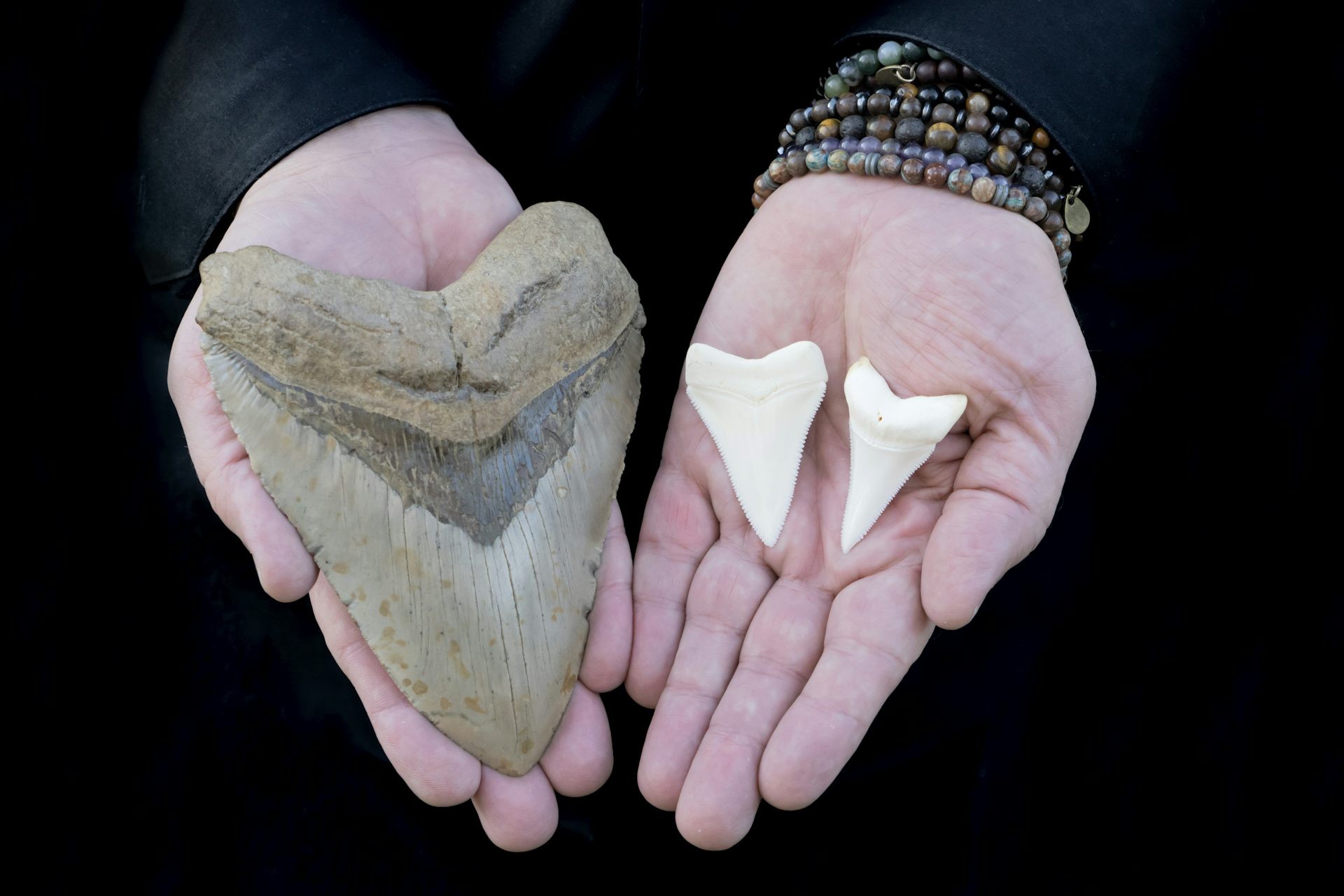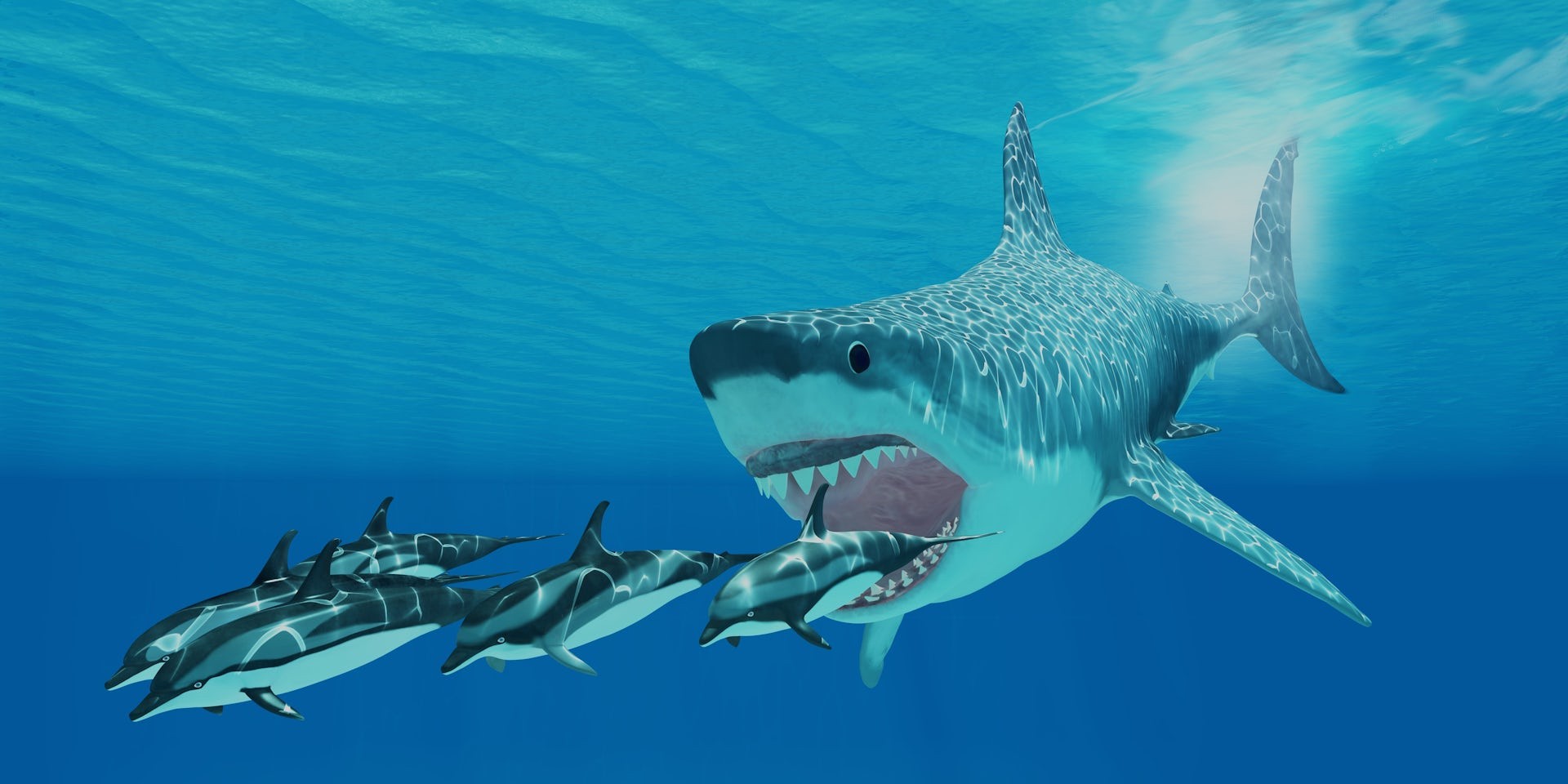Are you curious about the prehistoric seas and the giant predators that once ruled them? At WHY.EDU.VN, we explore the extinction of the megalodon, Otodus megalodon, offering insights into the factors that led to the demise of this apex predator. Discover the science-backed explanations for this fascinating event and expand your knowledge of marine paleontology. Explore related subjects like climate change, marine life, and fossil records.
1. The Reign of the Megalodon: A Prehistoric Giant
The megalodon, a name that evokes images of colossal power and prehistoric seas, was the largest shark that ever lived. Roaming the oceans between 23 and 3.6 million years ago, during the Early Miocene to the Pliocene epochs, this giant shark was an apex predator that dwarfed even the great white shark. Its scientific name, Otodus megalodon, hints at its massive teeth, which can reach over 7 inches in length. Imagine a shark with jaws capable of crushing a small car – that was the megalodon.
1.1. Physical Characteristics and Size
Megalodons were truly giants of the sea. Scientists estimate that they reached lengths of 50 to 60 feet (15 to 18 meters) and weighed up to 50 metric tons (110,000 pounds). This is significantly larger than the modern great white shark, which typically grows to about 20 feet. Their massive size allowed them to prey on large marine animals, including whales, seals, and other sharks.
1.2. Habitat and Distribution
Megalodons inhabited warm, shallow seas across the globe. Fossil evidence suggests they were found in the Pacific, Atlantic, and Indian Oceans. Their teeth have been discovered on every continent except Antarctica. This wide distribution indicates that megalodons were highly adaptable to different marine environments, as long as the water was warm enough.
1.3. Diet and Predatory Behavior
As apex predators, megalodons played a crucial role in regulating marine ecosystems. Their diet consisted primarily of large marine mammals, such as whales, dolphins, seals, and sea lions. Fossil evidence shows bite marks on the bones of these animals, confirming that megalodons were powerful and efficient hunters. They likely used their massive jaws and serrated teeth to crush bones and tear flesh, allowing them to quickly dispatch their prey.
2. The Mystery of Megalodon’s Extinction: Unraveling the Causes
Despite their dominance, megalodons eventually went extinct. The exact reasons for their disappearance are complex and likely involve a combination of factors. Here’s a deeper look into the primary drivers of their extinction:
2.1. Climate Change and Cooling Oceans
One of the most significant factors contributing to the extinction of megalodons was climate change. During the Pliocene epoch, the Earth experienced a period of global cooling. Ocean temperatures dropped significantly, particularly in polar regions. This change in climate had a profound impact on marine ecosystems and the distribution of marine life.
2.1.1. Impact on Megalodon’s Habitat
Megalodons were warm-water sharks, meaning they thrived in tropical and subtropical environments. As ocean temperatures cooled, their suitable habitat range shrank. They were forced to migrate to warmer waters, which became increasingly limited. This reduced habitat availability put a strain on their populations.
2.1.2. Changes in Prey Distribution
The cooling oceans also affected the distribution and abundance of megalodon’s prey. Many of the large marine mammals they relied on for food either migrated to different regions or experienced population declines. This made it more difficult for megalodons to find sufficient food, further contributing to their decline.
2.2. Competition with Emerging Predators
Another factor that likely played a role in the extinction of megalodons was competition from other predators. During the Pliocene, new species of marine mammals and sharks emerged, some of which competed with megalodons for the same food resources.
2.2.1. The Rise of the Great White Shark
The great white shark (Carcharodon carcharias) is one notable competitor. While much smaller than megalodons, great whites are highly efficient predators. They likely competed with juvenile megalodons for smaller prey and may have even scavenged on the same carcasses. The great white shark’s adaptability and ability to thrive in cooler waters gave it an advantage over megalodons.
2.2.2. Competition from Orcas and Other Marine Mammals
In addition to sharks, other marine mammals such as orcas (killer whales) also emerged as formidable predators. Orcas are highly intelligent and hunt in coordinated groups, allowing them to take down large prey. They may have competed with megalodons for whales and other marine mammals, further reducing megalodon’s food supply.
2.3. Decline in Prey Availability
The availability of suitable prey is crucial for the survival of any predator. As mentioned earlier, the cooling oceans led to changes in the distribution and abundance of marine mammals. Some species of whales and seals, which were important prey for megalodons, experienced population declines or migrated to different regions. This decline in prey availability made it more difficult for megalodons to sustain themselves.
2.3.1. The Evolution of Baleen Whales
One significant development was the evolution and diversification of baleen whales. These whales filter feed on small organisms like krill and plankton, rather than hunting large individual prey. This shift in prey availability may have made it more challenging for megalodons, which were adapted to hunting large marine mammals.
2.3.2. Changes in Whale Migration Patterns
Changes in ocean currents and temperatures also affected the migration patterns of whales. Some whale populations may have migrated to colder waters where megalodons could not follow, further reducing their access to prey.
2.4. Sea Level Changes and Coastal Habitats
Sea level fluctuations during the Pliocene also impacted coastal habitats, which were important for megalodon reproduction and feeding. Changes in sea level can alter the availability of shallow-water environments, affecting the distribution of prey and the suitability of breeding grounds.
2.4.1. Loss of Nursery Areas
Shallow coastal waters often serve as nursery areas for sharks, including megalodons. Changes in sea level can lead to the loss of these critical habitats, reducing the survival rate of juvenile sharks.
2.4.2. Impact on Prey Populations
Sea level changes can also affect the populations of prey species that inhabit coastal waters. Loss of habitat can lead to population declines, further reducing the food supply for megalodons.
3. Scientific Evidence Supporting Megalodon Extinction Theories
Scientists have gathered a wealth of evidence to support the various theories about megalodon extinction. This evidence comes from fossil records, geological studies, and climate modeling.
3.1. Fossil Distribution and Dating
The fossil record provides valuable information about the timing and distribution of megalodons. By analyzing the age and location of megalodon teeth, scientists have been able to determine when and where these sharks lived.
3.1.1. Absence of Recent Megalodon Fossils
One of the strongest pieces of evidence for megalodon extinction is the absence of any megalodon fossils younger than 3.6 million years old. Despite extensive searches and fossil discoveries, no teeth or other remains have been found that date to more recent times.
3.1.2. Changes in Fossil Distribution
Studies of megalodon fossil distribution have also revealed changes in their habitat range over time. As ocean temperatures cooled, megalodon fossils became increasingly concentrated in warmer regions, indicating a shrinking habitat range.
3.2. Isotope Analysis of Megalodon Teeth
Isotope analysis of megalodon teeth can provide insights into their diet and habitat. By measuring the ratios of different isotopes in the teeth, scientists can determine what megalodons were eating and the types of waters they inhabited.
3.2.1. Dietary Shifts
Isotope analysis has shown that megalodons primarily fed on large marine mammals. However, as prey populations declined, they may have been forced to broaden their diet or switch to less nutritious prey, which could have contributed to their decline.
3.2.2. Habitat Preferences
Isotope data also supports the idea that megalodons preferred warm waters. The isotopic composition of their teeth is consistent with that of sharks that live in tropical and subtropical environments.
3.3. Climate Reconstructions and Ocean Modeling
Climate reconstructions and ocean modeling provide information about past ocean temperatures and currents. These models can help scientists understand how climate change affected marine ecosystems and the distribution of marine life during the Pliocene.
3.3.1. Evidence of Global Cooling
Climate reconstructions show that the Earth experienced a period of significant global cooling during the Pliocene. Ocean temperatures dropped, particularly in polar regions, leading to changes in marine ecosystems.
3.3.2. Modeling Prey Distribution
Ocean models can also be used to simulate the distribution of marine mammals and other prey species. These models can help scientists understand how climate change affected prey availability for megalodons.
4. Debunking Myths: Do Megalodons Still Exist?
Despite the scientific evidence pointing to their extinction, rumors and myths persist that megalodons still exist in the deep oceans. These rumors are often fueled by sensationalized media reports and fictional stories. However, there is no credible evidence to support the idea that megalodons still roam the seas.
4.1. Lack of Evidence from Modern Sightings
One of the main arguments against the existence of modern megalodons is the lack of credible sightings. Megalodons were massive animals that lived in relatively shallow waters. If they still existed, they would likely be seen and photographed by fishermen, divers, or researchers. The absence of any confirmed sightings is strong evidence that they are extinct.
4.2. Implausibility of Remaining Undetected
Given their size and habitat preferences, it is highly improbable that megalodons could remain undetected for millions of years. The oceans have been extensively explored and monitored, and it is unlikely that such a large predator could have escaped observation.
4.3. The Deep Sea Myth
Some people argue that megalodons could still exist in the deep sea, where they would be less likely to be seen. However, this argument is flawed for several reasons. First, megalodons were adapted to warm, shallow waters, not the cold, dark depths of the ocean. Second, the deep sea has been explored by submarines and remotely operated vehicles, and no megalodons have been found.
5. Lessons from Megalodon: What Can We Learn?
The extinction of megalodons provides valuable insights into the dynamics of marine ecosystems and the impact of climate change. By studying their extinction, we can learn more about the factors that influence the survival of marine species and the importance of conservation efforts.
5.1. The Importance of Climate Stability
One of the key lessons from megalodon extinction is the importance of climate stability. Climate change can have profound impacts on marine ecosystems, altering habitats, prey distribution, and species interactions. Maintaining a stable climate is essential for the health and survival of marine life.
5.2. Understanding Predator-Prey Relationships
The extinction of megalodons also highlights the importance of understanding predator-prey relationships. Changes in prey availability can have cascading effects on predator populations, leading to declines or even extinction. Conserving prey species and managing fisheries sustainably is crucial for maintaining healthy marine ecosystems.
5.3. The Role of Competition in Evolution
Competition from other predators can also play a significant role in the survival of species. The emergence of new predators, such as great white sharks and orcas, may have contributed to the extinction of megalodons. Understanding the dynamics of competition can help us predict how species will respond to changes in their environment.
5.4. Adapting to Environmental Changes
The megalodon’s inability to adapt to changing environmental conditions ultimately led to its demise. This highlights the importance of adaptability for species survival. Species that can adapt to changes in climate, habitat, and prey availability are more likely to thrive in the face of environmental challenges.
6. FAQ: Common Questions About Megalodon Extinction
Here are some frequently asked questions about the extinction of megalodons, answered with the latest scientific knowledge:
| Question | Answer |
|---|---|
| When did megalodons go extinct? | Megalodons went extinct about 3.6 million years ago, during the Pliocene epoch. |
| What caused the extinction of megalodons? | The extinction was likely caused by a combination of factors, including climate change, competition from other predators, and a decline in prey availability. |
| Did climate change play a role? | Yes, climate change played a significant role. Cooling ocean temperatures reduced their habitat range and affected the distribution of their prey. |
| Did great white sharks contribute? | Great white sharks likely competed with juvenile megalodons for smaller prey, contributing to their decline. |
| Are there any megalodons alive today? | No, there is no credible evidence to support the idea that megalodons still exist. |
| How big were megalodons? | Megalodons reached lengths of 50 to 60 feet (15 to 18 meters) and weighed up to 50 metric tons (110,000 pounds). |
| What did megalodons eat? | Megalodons primarily ate large marine mammals, such as whales, dolphins, seals, and sea lions. |
| Where did megalodons live? | Megalodons inhabited warm, shallow seas across the globe, including the Pacific, Atlantic, and Indian Oceans. |
| How do scientists know about megalodons? | Scientists study megalodons through fossil records, isotope analysis, and climate modeling. |
| What can we learn from their extinction? | We can learn about the importance of climate stability, predator-prey relationships, and adaptability for species survival. |


7. The Enduring Legacy of the Megalodon
The megalodon may be extinct, but its legacy lives on. This colossal shark continues to capture our imagination and inspire awe. Its story serves as a reminder of the power of nature and the importance of understanding and protecting our marine ecosystems. By studying the megalodon and its extinction, we can gain valuable insights into the past, present, and future of our oceans.
8. Explore More with WHY.EDU.VN
Do you have more questions about prehistoric creatures, marine biology, or the mysteries of the natural world? WHY.EDU.VN is your go-to resource for accurate, expert-backed answers. Our team of specialists is dedicated to providing clear, comprehensive explanations to satisfy your curiosity.
8.1. Dive Deeper into Marine Paleontology
Discover more fascinating articles and resources on marine paleontology at WHY.EDU.VN. Learn about other extinct marine animals, the evolution of sharks, and the impact of climate change on marine life.
8.2. Ask Your Questions and Get Expert Answers
Still curious? Submit your questions to WHY.EDU.VN and receive answers from our team of experts. We’re here to help you explore the world around you and deepen your understanding of science and nature.
8.3. Join Our Community of Curious Minds
Connect with other curious learners and share your knowledge at WHY.EDU.VN. Our community is a place to ask questions, discuss ideas, and explore the wonders of the universe.
9. Conclusion: The Final Chapter for Megalodon
The extinction of the megalodon was a complex event driven by a combination of climate change, competition, and prey availability. While it’s tempting to imagine these giant sharks still lurking in the depths, the scientific evidence clearly indicates that they are gone. Their story serves as a powerful reminder of the fragility of ecosystems and the importance of conservation.
10. Call to Action: Explore, Learn, and Ask at WHY.EDU.VN
Are you fascinated by the megalodon and want to learn more about the prehistoric world? Do you have questions about other scientific topics and need reliable answers? Visit WHY.EDU.VN today!
We understand the challenges of finding accurate and trustworthy information online. That’s why we’ve created a platform where you can get expert answers to your questions, explore a wide range of topics, and connect with a community of curious learners.
10.1. Get Your Questions Answered by Experts
Our team of specialists is ready to provide you with detailed, easy-to-understand explanations. Whether you’re a student, a professional, or simply someone with a thirst for knowledge, WHY.EDU.VN is here to help.
10.2. Explore a Wealth of Knowledge
Discover a vast library of articles, resources, and videos on a wide range of topics, from science and technology to history and culture. Our content is carefully curated and vetted to ensure accuracy and reliability.
10.3. Connect with a Community of Learners
Join our community of curious minds and share your knowledge, ask questions, and discuss ideas with other learners from around the world.
10.4. Contact Us
Have questions or need assistance? Contact us today:
- Address: 101 Curiosity Lane, Answer Town, CA 90210, United States
- WhatsApp: +1 (213) 555-0101
- Website: WHY.EDU.VN
Don’t let your curiosity go unanswered. Visit why.edu.vn today and start exploring the world of knowledge. We look forward to helping you discover, learn, and grow.
